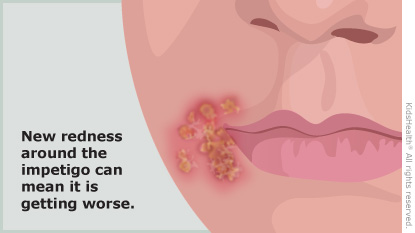Impetigo: How to Care for Your Child
Impetigo is a skin infection caused by bacteria (a type of germ) that causes sores or blisters. It is treated with an antibiotic, either applied as an ointment or cream or taken by mouth. Impetigo (im-peh-TY-go) can spread easily to other parts of the body and to other people when someone touches an infected skin area or something (like a towel) that touched an infected area. Follow these instructions to care for your child and help prevent the infection from spreading.


-
Use the antibiotic as prescribed by your health care provider. Don't stop using the medicine early even if the infection looks better, because the infection could come back.
-
Wash the area twice a day (or right before using an antibiotic cream or ointment, if prescribed) with soap and warm water. Carefully pat the skin dry with a paper towel, and then throw the paper towel away. Or use a clean towel each time. Wash it in hot water and dry it on high heat before using it again.
-
To prevent the infection from spreading:
-
Wash hands with soap and water before and after caring for the skin.
-
Cover sores with a clean bandage or dry gauze and tape until completely healed.
-
Wash towels in hot water and dry on high heat after each use.
-
Remind your child not to touch the infected skin.
-
Don't have your child share clothes, towels, or bedding with other family members until the sores are healed.
-
Everyone in your household should wash their hands well and often (or use alcohol-based hand sanitizer).
-
Your child can return to school or childcare after using the antibiotic ointment or taking the antibiotic medicine by mouth for 24 hours. Remember to keep the sores covered until completely healed.

-
The sores are not getting better after using the antibiotic ointment or medicine by mouth for 2 days.
-
Your child starts to feel sick with fever, loss of appetite, or low energy.
-
The infected skin gets redder, warmer, or more swollen, or the sores look worse.
-
The impetigo goes away and then comes back.

Your child develops severe pain of the infected skin; swelling of the hands, feet, or face; or blood-tinged pee. Very rarely, impetigo can spread to deeper parts of the skin or affect the kidneys.

What causes impetigo? Impetigo is an infection of the skin's top layers. It can happen on healthy skin or on skin that has a rash, scratch, or cut. Staphylococcus aureus (staph) or group A streptococcus (strep) bacteria cause most cases, but some are caused by Methicillin-resistant Staphylococcus aureus (MRSA).
What happens with impetigo? The infection begins with small blisters that can burst and leave patches of red skin. These sores may ooze fluid that dries, leaving a honey-colored crust. Sometimes the blisters are larger and may not burst. Impetigo can be very itchy.
What can help prevent impetigo? Anyone can get impetigo, but to make it less likely:
-
Wash hands with soap and water (or alcohol-based hand sanitizer) regularly.
-
Keep areas of eczema (dry skin patches), cuts, rashes, and bug bites clean and covered.
-
Don't share towels, clothes, or other personal items.
-
Keep fingernails cut short and clean them regularly.